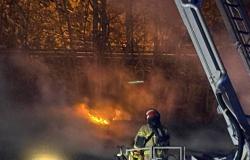
(The Østlendingen): – The queues stretched far out on national highway 3, says general manager at Circle K Alvdal, Henrik Granrud Trøen, to the Østlendingen.
At Circle K in Alvdal, there are a total of six CCS charging points from the charging operator Ionity.
In the same area, Tesla has 36 CCS chargers, which are open to cars other than Tesla’s own.
Recharge has ten charging points for CCS charging points and two CHAdeMO charging points at the Shell station in Alvdal.
Charging standard CHAdeMO
- Originally a Japanese charging standard, which Peugeot, Citroen and Kia now also use on their electric cars.
- Used today by, among others, Citroen C-Zero, Citroen Berlingo, Kia Soul, Nissan Leaf, Nissan e-NV200, Mitsubishi i-Miev, Peugeot Partner and Peugeot iOn.
- In addition, Tesla can use this with the help of a transition, even if charging then goes slower than with Tesla’s own Supercharger. CHAdeMO can charge up to 63 kW per hour.
Source: NAF
Charging standard CCS
- This charging standard has been developed by American and European car manufacturers and satisfies several users.
- When using a fast charger, the plug uses both ports.
- One part (with three pins) communicates with the car, while the other transports the current.
- CCS is currently used by, among others, BMW, Hyundai, Opel, Chevrolet, Volkswagen, as well as the Tesla Model 3. This can theoretically provide 350 kW per hour, but in practice it is about 50 to 150 kW per hour at public charging points.
Source: NAF
Scared
Trøen is alarmed that the loading queues were left out on national highway 3. It is directly dangerous for traffic, he emphasizes.
He has a wish to expand the charging offer at the station. This requires the area around the petrol station to be expanded.
– Our neighbor on the north side wanted to sell part of his plot to us, so that we could expand the offer and thus prevent what happened at the weekend. We have received a refusal from the municipality, because they believed that it was cultivated land, even though this part of the plot has not been cultivated for 15–20 years, says Trøen.
The neighbour, farmer and landowner Ida Steihaug, has previously spoken positively of the sale.
– This is a narrow piece of the land that I have further in, and is not suitable for today’s tools that are used for managing the land, she said to Alvdal in the middle of Väla last summer.
Measure for more chargers
Trøen thinks it’s a shame that he – through the company Granrud Næringsbygg AS – has not been able to buy the land on which he could imagine building charging stations.
The aim is to become an energy station with more electric car chargers than petrol pumps.
– We see very clearly that this is the way to go. That’s why we try to be ahead of the curve, both in terms of traffic safety and the green shift. It is stupid that we meet resistance, he says.
Several chargers believe he would have given Alvdal a better reputation.
– People who stop in Alvdal should think it’s nice here, not just queues and chaos. More chargers will create a good reputation, while at the same time we are getting ready for the needs that will come in the future, says Trøen to Østlendingen.
– Just think about the summer. This can become very dangerous in terms of traffic, when extremely many people are going out and speeding at the same time. Such loading queues are not only dangerous, they also block the way for both people and the transport of food and all sorts of things. This slows down society, if more is not facilitated, he says.
Fantasizing about “load house”
– Do you have alternative plans for how the development of chargers can take place?
– You can imagine a large car park with chargers, but that doesn’t work in practice. It is a billion-dollar dream that is unlikely to come true. Not at all. It’s just a fantasy, replies Trøen.
In Elverum, charging chaos was also reported at Easter, despite a significantly larger charging offer than in Alvdal.
Here both Tesla, Mer, Recharge, Ionity, Eviny and Kople have dozens of charging points around the city.
– It was completely crazy. Absolutely hopeless, says Baard Amundsen from Oslo to VG.
He himself gave up charging at the two large charging destinations in Østerdalen, Elverum and Alvdal.
He ended up finding a charging station at Rena. Here he only stood in the charging queue for half an hour.
How to avoid charging queues
Secretary General of the Electric Vehicle Association, Christina Bu, tells VG that she had hopes that this year’s Easter would be better for charging electric vehicles.
She points out that 2,000 new charging points have been built in Norway in the past year alone.
– In Norway there are now 8,000 fast chargers for electric cars. So that’s a positive backdrop. But when there is a queue on the road, the queues at the fast chargers can quickly pile up on special departure days, says Bu.
She has two pieces of good advice for electric motorists on tour.
– Charge when you can, not when you have to. And don’t stand until you have 100 percent battery. It takes the longest to charge the last percent of the car, she says.
Tags: Electric car Charging Fantasizing charging houses avoid trafficdangerous charging chaos
-




